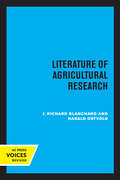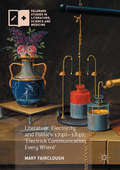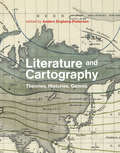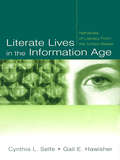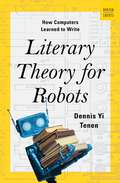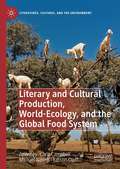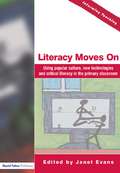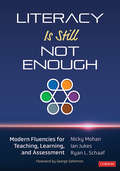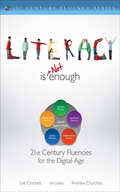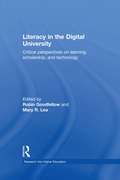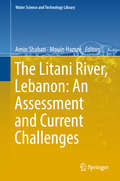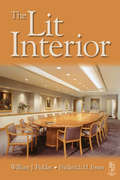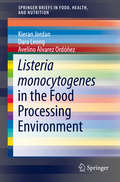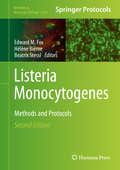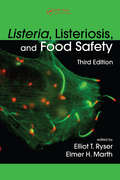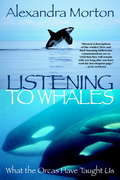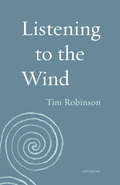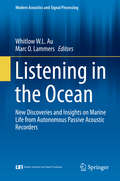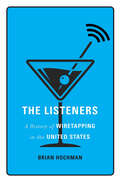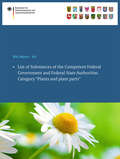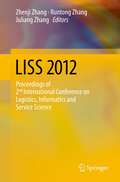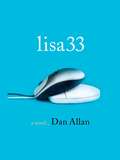- Table View
- List View
Literature of Agricultural Research
by J. Richard Blanchard Harald OstvoldThis title is part of UC Press's Voices Revived program, which commemorates University of California Press’s mission to seek out and cultivate the brightest minds and give them voice, reach, and impact. Drawing on a backlist dating to 1893, Voices Revived makes high-quality, peer-reviewed scholarship accessible once again using print-on-demand technology. This title was originally published in 1958.
Literature, Electricity and Politics 1740–1840
by Mary FaircloughThis book investigates the science of electricity in the long eighteenth century and its textual life in literary and political writings. Electricity was celebrated as a symbol of enlightened progress, but its operation and its utility were unsettlingly obscure. As a result, debates about the nature of electricity dovetailed with discussions of the relation between body and soul, the nature of sexual attraction, the properties of revolutionary communication and the mysteries of vitality. This study explores the complex textual manifestations of electricity between 1740 and 1840, in which commentators describe it both as a material force and as a purely figurative one. The book analyses attempts by both elite and popular practitioners of electricity to elucidate the mysteries of electricity, and traces the figurative uses of electrical language in the works of writers including Mary Robinson, Edmund Burke, Erasmus Darwin, John Thelwall, Mary Shelley and Richard Carlile.
Literature and Cartography: Theories, Histories, Genres (The\mit Press Ser.)
by Anders Engberg-PedersenThe relationship of texts and maps, and the mappability of literature, examined from Homer to Houellebecq.Literary authors have frequently called on elements of cartography to ground fictional space, to visualize sites, and to help readers get their bearings in the imaginative world of the text. Today, the convergence of digital mapping and globalization has spurred a cartographic turn in literature. This book gathers leading scholars to consider the relationship of literature and cartography. Generously illustrated with full-color maps and visualizations, it offers the first systematic overview of an emerging approach to the study of literature.The literary map is not merely an illustrative guide but represents a set of relations and tensions that raise questions about representation, fiction, and space. Is literature even mappable? In exploring the cartographic components of literature, the contributors have not only brought literary theory to bear on the map but have also enriched the vocabulary and perspectives of literary studies with cartographic terms. After establishing the theoretical and methodological terrain, they trace important developments in the history of literary cartography, considering topics that include Homer and Joyce, Goethe and the representation of nature, and African cartographies. Finally, they consider cartographic genres that reveal the broader connections between texts and maps, discussing literary map genres in American literature and the coexistence of image and text in early maps. When cartographic aspirations outstripped factual knowledge, mapmakers turned to textual fictions.ContributorsJean-Marc Besse, Bruno Bosteels, Patrick M. Bray, Martin Brückner, Tom Conley, Jörg Dünne, Anders Engberg-Pedersen, John K. Noyes, Ricardo Padrón, Barbara Piatti, Simone Pinet, Clara Rowland, Oliver Simons, Robert Stockhammer, Dominic Thomas, Burkhardt Wolf
Literature After Darwin
by Virginia RichterWhat makes us human? Where is the limit between human and animal? These are questions that haunt post-Darwinian literature. Covering fiction from Kipling to Kafka, this study offers a historically embedded analysis of anthropological anxiety in the period between the publication of the Origin of Species and the beginning of the Second World War.
Literate Lives in the Information Age: Narratives of Literacy From the United States
by Cynthia L. Selfe Gail E. HawisherThis book chronicles the development of electronic literacies through the stories of individuals with varying backgrounds and skills. Authors Cynthia L. Selfe and Gail E. Hawisher employ these stories to begin tracing technological literacy as it has emerged over the last few decades within the United States. They selected 20 case studies from the corpus of more than 350 people who participated in interviews or completed a technological literacy questionnaire during six years of their study. The book is organized into seven chapters that follow the 20 participants in their efforts to acquire varying degrees of technological literacy. Each chapter situates the participants' life-history accounts in the cultural ecology of the time, tracing major political, economic, social, and educational events, factors, and trends that may have influenced--and been influenced by--literacy practices and values. These literacy histories are richly sown with information that can help those in composition and writing studies situate the processes of acquiring the literacies of technology in specific cultural, material, educational, and familial contexts. These case studies provide initial clues about combinations of factors that affect--and are affected by--technological literacy acquisition and development. The first-hand accounts presented here offer, in abundant detail, everyday literacy experiences that can help educators, parents, policymakers, and writing teachers respond to today's students in more informed ways.
Literary Theory for Robots: How Computers Learned to Write (A Norton Short #0)
by Dennis Yi TenenIn the industrial age, automation came for the shoemaker and the seamstress. Today, it has come for the writer, physician, programmer, and attorney. Literary Theory for Robots reveals the hidden history of modern machine intelligence, taking readers on a spellbinding journey from medieval Arabic philosophy to visions of a universal language, past Hollywood fiction factories and missile defense systems trained on Russian folktales. In this provocative reflection on the shared pasts of literature and computer science, former Microsoft engineer and professor of comparative literature Dennis Yi Tenen provides crucial context for recent developments in AI, which holds important lessons for the future of humans living with smart technology. Intelligence expressed through technology should not be mistaken for a magical genie, capable of self-directed thought or action. Rather, in highly original and effervescent prose with a generous dose of wit, Yi Tenen asks us to read past the artifice—to better perceive the mechanics of collaborative work. Something as simple as a spell-checker or a grammar-correction tool, embedded in every word-processor, represents the culmination of a shared human effort, spanning centuries. Smart tools, like dictionaries and grammar books, have always accompanied the act of writing, thinking, and communicating. That these paper machines are now automated does not bring them to life. Nor can we cede agency over the creative process. With its masterful blend of history, technology, and philosophy, Yi Tenen’s work ultimately urges us to view AI as a matter of labor history, celebrating the long-standing cooperation between authors and engineers.
Literary and Cultural Production, World-Ecology, and the Global Food System (Literatures, Cultures, and the Environment)
by Chris Campbell Michael Niblett Kerstin OloffLiterary and Cultural Production, World-Ecology, and the Global Food System marks a significant intervention into the field of literary food studies. Drawing on new work in world literature, cultural studies, and environmental studies, the essays gathered here explore how literary and cultural texts have represented and responded to the global food system from the late nineteenth century to the present day. Covering topics such as the impact of colonial monocultures and industrial agriculture, enclosure and the loss of the commons, the meatification of diets, the toxification of landscapes, and the consequences of climate breakdown, the volume ranges across the globe, from Thailand to Brazil, Cyprus to the Caribbean. Whether it is anxieties over imported meat in late Victorian Britain, labour struggles on Guatemalan banana plantations, or food dependency in Puerto Rico, the contributors to this volume show how fiction, poetry, drama, film, and music have critically explored and contributed to food cultures worldwide.
Literacy Moves On: Using Popular Culture, New Technologies and Critical Literacy in the Primary Classroom
by Janet EvansThis book looks at the changing nature of literacy and at the way in which new and different literacies are emerging in the first part of the 21st century. It considers how children are shaping and being shaped by these changes, it also looks at how teachers need to bridge-the-gap between children's out of school interests and school based curriculum demands. This edited collection, which features chapters by international experts and voices in the field, aims to: Take a closer look at (and demystify) some of the influences on literacy in the 21st century e.g. popular culture, multi-modal texts, email, text messaging and critical literacy. Enhance teachers' awareness of these developments and show how they can use them to improve the literacy skills of their pupils. Show, through the Implications for Practice sections, how teachers can find different but straightforward ways of linking children's personal, out-of-school interests with the demands of the school curriculum.
Literacy Is Still Not Enough: Modern Fluencies for Teaching, Learning, and Assessment
by Ian Jukes Nicky Mohan Ryan L. SchaafModern fluencies provide a platform for authentic teaching, learning, and assessment While reading, writing, and arithmetic remain important, they are no longer enough. For learners to thrive, they must move beyond traditional literacies to modern fluencies—the unconscious mental processes that are learned, adapted, and applied in the context of real-world problems and challenges. In this book, the authors unpack the fluencies (solution, information, creativity, communication, collaboration, and global citizenship) to reflect the relentless social, cultural, and economic shifts of modern times. Practical resources are presented alongside: Authentic Unit Plan Exemplars for each fluency Assessment rubric examples Discussion questions Learners today must master an entirely different set of essential skills and knowledge needed to succeed than previous generations. This book provides a practical framework for integrating new fluencies into traditional curriculum.
Literacy Is Still Not Enough: Modern Fluencies for Teaching, Learning, and Assessment
by Ian Jukes Nicky Mohan Ryan L. SchaafModern fluencies provide a platform for authentic teaching, learning, and assessment While reading, writing, and arithmetic remain important, they are no longer enough. For learners to thrive, they must move beyond traditional literacies to modern fluencies—the unconscious mental processes that are learned, adapted, and applied in the context of real-world problems and challenges. In this book, the authors unpack the fluencies (solution, information, creativity, communication, collaboration, and global citizenship) to reflect the relentless social, cultural, and economic shifts of modern times. Practical resources are presented alongside: Authentic Unit Plan Exemplars for each fluency Assessment rubric examples Discussion questions Learners today must master an entirely different set of essential skills and knowledge needed to succeed than previous generations. This book provides a practical framework for integrating new fluencies into traditional curriculum.
Literacy Is NOT Enough: 21st Century Fluencies for the Digital Age
by Lee Crockett Ian Jukes Andrew ChurchesHow to upgrade literacy instruction for digital learners Educating students to traditional literacy standards is no longer enough. If students are to thrive in their academic and 21st century careers, then independent and creative thinking hold the highest currency. The authors explain in detail how to add these new components of literacy: Solution Fluency Information Fluency Creativity Fluency Collaboration Fluency Students must master a completely different set of skills to succeed in a culture of technology-driven automation, abundance, and access to global labor markets. The authors present an effective framework for integrating comprehensive literacy or fluency into the traditional curriculum.
Literacy in the Digital University: Critical perspectives on learning, scholarship and technology (Research into Higher Education)
by Robin Goodfellow Mary R. LeaLiteracy in the Digital University is an innovative volume bringing together perspectives from two fields of enquiry and practice: ‘literacies and learning’ and ‘learning technologies’. With their own histories and trajectories, these fields have seldom overlapped either in practice, theory, or research. In tackling this divide head on, the volume breaks new ground. It illustrates how complementary and contrasting approaches to literacy and technology can be brought together in productive ways and considers the implications of this for practitioners working across a wide range of contexts. The book showcases work from well-respected authorities in the two fields in order to provide the foundations for new conversations about learning and practice in the digital university. It will be of particular relevance to university teachers and researchers, educational developers and learning technologists, library staff, university managers and policy makers, and, not least, learners themselves, particularly those studying at post-graduate level.
The Litani River, Lebanon: An Assessment and Current Challenges (Water Science and Technology Library #85)
by Mouin Hamzé Amin ShabanThis book presents a collection of chapters covering research on the Litani River Basin. The Litani River Basin occupies about a quarter of Lebanon's surface area, and it has recently been subject to severe geo-environmental conditions such as water contamination and decreased discharge. This motivated the Lebanese government to take action and start working on the remediation of the river. These actions are also supported by international organizations including the World Bank.
Lit Interior
by Frederick H Jones William J FielderPresents an organised, comprehensive and easy to understand overview of the lighting design process. It covers every topic from the nature of light itself, through selecting the correct equipment, to preparing project plans and the finished design documents.Using a dummy example the student is taken through an entire project step by step where the full range of alternatives and design processes are illustrated. The easy to read conversational tone makes the novice feel at home with complex technical concepts and provides an excellent introduction to all newcomers to the subject. The book is ideal for those working in architecture, electrical engineering and interior design who will one day design lighting systems for others to build.A companion website runs alongside the book, at http://litinterior.com/, supporting distance learning projects, providing manufacturers data, calculation engines and downloadable courses for carrying our design exercises. The content of the courses will be linked directly to the book.Includes US codes and standards.
Listeria monocytogenes in the Food Processing Environment
by Kieran Jordan Dara Leong Avelino Álvarez OrdóñezThis Brief focuses on Listeria monocytogenes, from isolation methods and characterization (including whole genome sequencing), to manipulation and control. Listeriosis, a foodborne disease caused by Listeria monocytogenes is a major concern for public health authorities. In addition, addressing issues relating to L. monocytogenes is a major economic burden on industry. Awareness of its ubiquitous nature and understanding its physiology and survival are important aspects of its control in the food processing environment and the reduction of the public health concern.
Listeria Monocytogenes: Methods and Protocols (Methods in Molecular Biology #2220)
by Edward M. Fox Hélène Bierne Beatrix StesslThis updated book explores a wide repertoire of tools and approaches that have been created, modified, and applied to the study of L. monocytogenes, forming the basis of our understanding of the bacterium today. Many of these key experimental techniques are gathered together herein. The volume presents aspects such as clinical disease and host-pathogen interactions, as well as the study of biofilms which present a significant challenge for control of the organism in the food processing environment. The topics covered in this edition also include sampling in order to isolate Listeria, methods for their identification and characterization, methods for gene manipulation, and methods for control of the organism. Written for the highly successful Methods in Molecular Biology series, chapters include introductions to their respective topics, lists of the necessary materials and reagents, step-by-step, readily reproducible laboratory protocols, and tips on troubleshooting and avoiding known pitfalls. Authoritative and up-to-date, Listeria monocytogenes: Methods and Protocols, Second Edition aims to contribute toward the harmonization of methods used to study this important bacterium, and to be of particular interest to Listeria research both in relation to food association and control as well as clinical microbiology.
Listeria, Listeriosis, and Food Safety (ISSN)
by Elliot T. Ryser Elmer H. MarthSince the second edition of Listeria, Listeriosis, and Food Safetywas published in 1999, the United States has seen a 40 percent decline in the incidence of listeriosis, with the current annual rate of illness rapidly approaching the 2010 target of 2.5 cases per million. Research on this food-borne pathogen, however, has continued unabated,
Listening to Whales: What the Orcas Have Taught Us
by Alexandra MortonIn Listening to Whales, Alexandra Morton shares spellbinding stories about her career in whale and dolphin research and what she has learned from and about these magnificent mammals. In the late 1970s, while working at Marineland in California, Alexandra pioneered the recording of orca sounds by dropping a hydrophone into the tank of two killer whales. She recorded the varied language of mating, childbirth, and even grief after the birth of a stillborn calf. At the same time she made the startling observation that the whales were inventing wonderful synchronized movements, a behavior that was soon recognized as a defining characteristic of orca society. In 1984, Alexandra moved to a remote bay in British Columbia to continue her research with wild orcas. Her recordings of the whales have led her to a deeper understanding of the mystery of whale echolocation, the vocal communication that enables the mammals to find their way in the dark sea. A fascinating study of the profound communion between humans and whales, this book will open your eyes anew to the wonders of the natural world.From the Trade Paperback edition.
Listening to Whales: What The Orcas Have Taught Us
by Alexandra MortonAlexandra Morton shares spellbinding stories about her career in whale and dolphin research and what she has learned from and about these magnificent mammals. In the late 1970s, while working at Marineland in California, Alexandra pioneered the recording of orca sounds by dropping a hydrophone into the tank of two killer whales. She recorded the varied language of mating, childbirth, and even grief after the birth of a stillborn calf. At the same time she made the startling observation that the whales were inventing wonderful synchronized movements, a behavior that was soon recognized as a defining characteristic of orca society. In 1984, Alexandra moved to a remote bay in British Columbia to continue her research with wild orcas. Her recordings of the whales have led her to a deeper understanding of the mystery of whale echolocation, the vocal communication that enables the mammals to find their way in the dark sea. A fascinating study of the profound communion between humans and whales, this book will open your eyes anew to the wonders of the natural world.
Listening to the Wind
by Tim RobinsonA mapmaker’s vivid journey through the geography, ecology, and history of Ireland’s Connemara region.Here is Connemara, experienced at a walker’s pace. From cartographer Tim Robinson comes the second title in the Seedbank series, a breathtakingly intimate exploration of one beloved place’s geography, ecology, and history.We begin with the earth right in front of his boots, as Robinson unveils swaths of fiontarnach—fall leaf decay. We peer from the edge of the cliff where Robinson’s house stands on rickety stilts. We closely examine an overgrown patch of heather, a flush of sphagnum moss. And so, footstep by footstep, moment by moment, Robinson takes readers deep into this storied Irish landscape, from the “quibbling, contentious terrain” of Bogland to the shorelines of Inis Ní to the towering peaks of Twelve Pins.Just as wild and essential as the countryside itself are its colorful characters, friends and legends and neighbors alike: a skeletal, story-filled sheep farmer; an engineer who builds bridges, both physical and metaphorical; a playboy prince and cricket champion; and an enterprising botanist who meets an unexpected demise. Within a landscape lie all other things, and Robinson rejoices in the universal magic of becoming one with such a place, joining with “the sound of the past, the language we breathe, and our frontage onto the natural world.” Situated at the intersection of mapmaking and mythmaking, Listening to the Wind is at once learned and intimate, elegiac and magnificent—an exceptionally rich “book about one place which is also about the whole world” (Robert Macfarlane).“Visitors to Connemara, that expanse of stony beauty in the west of Ireland, are often struck by its stillness. [This] collection of essays succeeds in the difficult task of staying true to the verities of a place on to which so many fantasies have been projected.” —The Guardian
Listening in the Ocean
by Whitlow W. L. Au Marc O. LammersThis title brings to light the discoveries and insights into the lives of many marine species made possible over the last decade by passive acoustic recorders (PAR). Pop-ups, ARF, HARP, EAR, Bprobe, C-POD Atag, and Dtag are the acronyms of some of the many PARs that have changed our understanding of how marine animals live and strive in the ocean. Various types of PARs are used by different investigators in different areas of the world. These recorders have accumulated copious amounts of very important data, unveiling previously unknown information about large marine animals. Temporal, seasonal and spatial distribution patterns have been uncovered for many marine species. There have been many discoveries, new understandings and insights into how these animals live in and utilize the ocean and the importance of acoustics in their lives. Listening Within the Ocean summarizes these important discoveries, providing both a valuable resource for researchers and enjoyable reading for non-professionals interested in marine life.
The Listeners: A History of Wiretapping in the United States
by Brian HochmanThey’ve been listening for longer than you think. A new history reveals how—and why. Wiretapping is nearly as old as electronic communications. Telegraph operators intercepted enemy messages during the Civil War. Law enforcement agencies were listening to private telephone calls as early as 1895. Communications firms have assisted government eavesdropping programs since the early twentieth century—and they have spied on their own customers too. Such breaches of privacy once provoked outrage, but today most Americans have resigned themselves to constant electronic monitoring. How did we get from there to here? In The Listeners, Brian Hochman shows how the wiretap evolved from a specialized intelligence-gathering tool to a mundane fact of life. He explores the origins of wiretapping in military campaigns and criminal confidence games and tracks the use of telephone taps in the US government’s wars on alcohol, communism, terrorism, and crime. While high-profile eavesdropping scandals fueled public debates about national security, crime control, and the rights and liberties of individuals, wiretapping became a routine surveillance tactic for private businesses and police agencies alike. From wayward lovers to foreign spies, from private detectives to public officials, and from the silver screen to the Supreme Court, The Listeners traces the long and surprising history of wiretapping and electronic eavesdropping in the United States. Along the way, Brian Hochman considers how earlier generations of Americans confronted threats to privacy that now seem more urgent than ever.
List of Substances of the Competent Federal Government and Federal State Authorities
by Bundesamt Für Verbraucherschutz Und Lebe StaffList of Substances of the Competent Federal Government and Federal State Authorities Plants and plant preparations are an important part of a balanced diet. Apart from using them as fruit, vegetables or cereals we can also enjoy them as ingredients in the form of herbs or spices or enjoy them in teas. More and more exotic plants are also available whose use as food in Germany was not known up to now. Supermarkets and drugstores also sell an increasing number of products which supposedly benefit health and contain preparations which were previously used in Germany above all in pharmaceutical products. The present category "Plants and plant parts" of the List of Substances of the Competent Federal Government and Federal State Authorities was provided to facilitate the classification and evaluation of plants and plant parts regarding their use as food or food ingredients. In addition to classification under formal legal aspects the list also provides information on the possible risks involved with certain uses. The list of substances is intended as a guideline for authorities and those placing products on the market.
LISS 2012
by Juliang Zhang Runtong Zhang Zhenji ZhangInformation and communication technology has helped to provide a more effective network infrastructure and development platform for logistics and service operations. In order to meet the needs of consumers, and particularly to promote low-carbon development processes, new types of services will also emerge. LISS 2012 is a prime international forum for both researchers and industry practitioners to exchange the latest fundamental advances in the state of the art and practice of logistics, informatics, service operations and service science. Experts and researchers from related fields will discuss current issues and future development opportunities, discuss and analyze developing trends and exchange the latest research and academic thought. The theme of the conference is Logistics and Service Science based on the Internet of Things.
Lisa33: A Novel
by Dan AllanIt’s circa 1999 and the first sex chat rooms are in full swing. Late at night as his family sleeps, “Tag,” a lawyer trapped in the golden handcuffs of a loveless marriage, makes his inaugural visit to the newly launched Literoticus.com. He can’t believe what he’s stumbled into. This freewheeling world of lonely misfits engaged in unbridled sexual activity is both shocking and intriguing. When Tag encounters the witty, insightful, and occasionally scathing “Lisa33,” he feels a chemistry that has eluded him his entire marriage. Late-night honesty builds into sexual and emotional obsession, the kind that makes you think you are capable of changing your whole life. But what Dan Allan’s characters fail to anticipate is how hard it is to translate fantasy into reality. As personal discontents begin to intrude on this virtual erotic eden, Lisa’s longing for something better collides with Tag’s inability to step beyond the boundaries of his own very narrow life, and Lisa makes a heartbreaking choice. A heartfelt, profound, and highly original novel that both satirizes and utterly transcends the Internet craze, Lisa33 captures the longing for transformation through fantasy and brings to life the hilarious, weird community of self-invented characters who step into chat rooms in order to step out of the loneliness, fear, and sorrow of real life.
